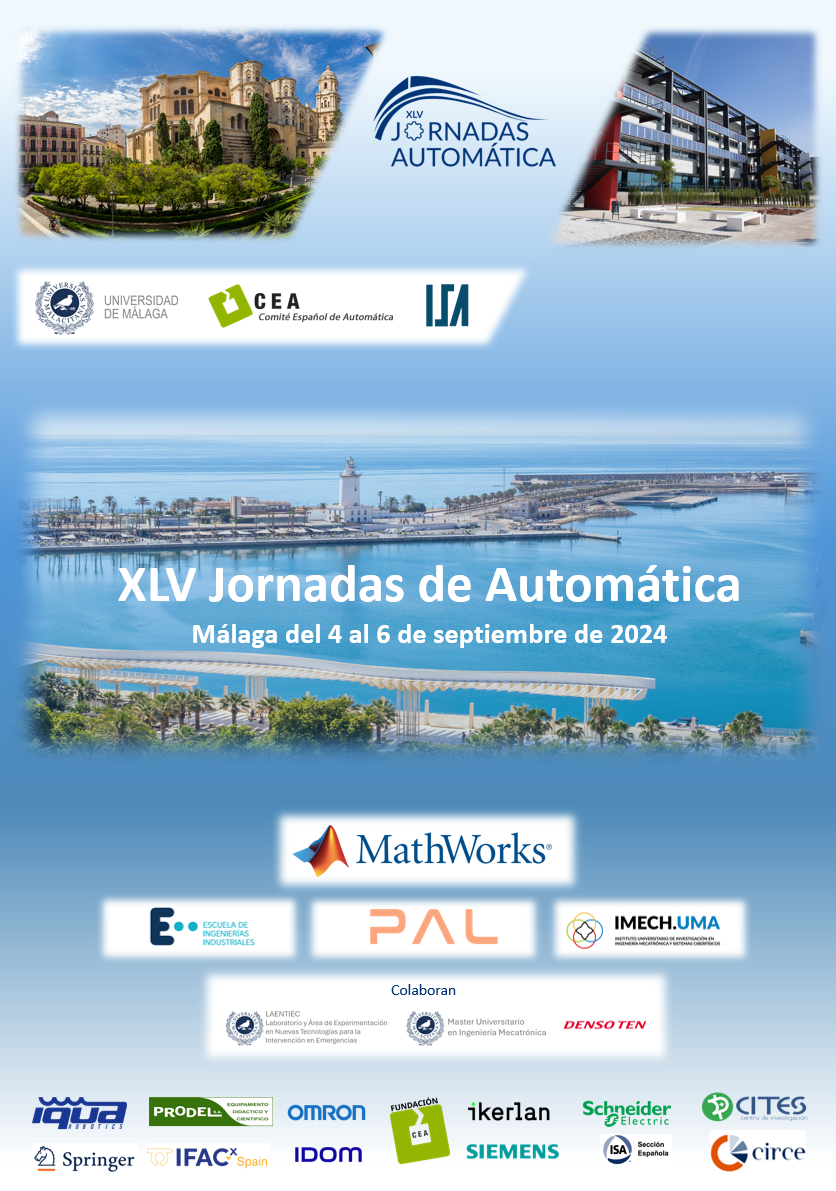Sistema de monitorización de entornos para usuarios de sillas de ruedas
DOI:
https://doi.org/10.17979/ja-cea.2024.45.10762Palabras clave:
Tecnología asistencial e ingeniería de rehabilitación, Fusión de información y sensores, Control de vibraciones, Diseño de experimentos, Metodologías de diseñoResumen
Este estudio aborda el desafío de hacer un seguimiento de los entornos de desplazamiento de los usuarios de sillas de ruedas, con el objetivo de proporcionar al personal sanitario datos cuantificables sobre su actividad diaria. Se presenta un sistema de monitorización que realiza un seguimiento continuo y en tiempo real de las variables cinemáticas y ambientales, analizando los efectos del movimiento de la silla y los factores externos en el estado funcional del usuario. El sistema integra una IMU, dos encoders y un sensor de humedad y temperatura en una silla de ruedas eléctrica. Para la validación del sistema se han realizado pruebas en diversos entornos, como rampas, giros bruscos, ascensores y baches, confirmando su eficacia. Este dispositivo robusto y fiable proporciona a los profesionales la información necesaria sobre el contexto específico de cada usuario, lo que contribuye a mejorar los tratamientos de rehabilitación y, en consecuencia, su calidad de vida.
Referencias
Arias, D. E., Pino, E. J., Aqueveque, P., Curtis, D. W., 2016. Unobtrusive support system for prevention of dangerous health conditions in wheelchair users. Mobile Information Systems, 362–367. DOI: 10.1155/2016/4568241
Chen, P.-W. B., Morgan, K., 1 2018. Toward community-based wheelchair evaluation with machine learning methods. Journal of Rehabilitation and Assistive Technologies Engineering 5, 1–9. DOI: 10.1177/2055668318808409
Dziechciowski, Z., Kromka-Szydek, M., 3 2017. Vibration transmitted to the human body during the patient’s ride in a wheelchair. Archives of Acoustics 42, 137–148. DOI: 10.1515/AOA-2017-0015
FMdP, F. M. d. P. (Ed.), 2019. Movilidad reducida y accesibilidad en edificios de viviendas. Hábitos y necesidades de las personas con movilidad reducida. Fundación Mutua de Propietarios, Madrid.
Garcia-Mendez, Y., Pearlman, J. L., Boninger, M. L., Cooper, R. A., 2013. Health risks of vibration exposure to wheelchair users in the community. The Journal of Spinal Cord Medicine 36(4):365-75. DOI: 10.1179/2045772313Y.0000000124
Gionata, C., Francesco, F., Alessandro, F., Sabrina, I., Andrea, M., 2014. An inertial and qr code landmarks-based navigation system for impaired wheelchair users. Ambient Assisted Living, 205–214. DOI: 10.1007/978-3-319-01119-621
Hashizume, T., Kitagawa, H., Yoneda, I., Takami, M., Fujisawa, S., Sueda, O., Kamata, M., 2008. Study on the wheelchair user’s body vibration and wheelchair driving torque when wheelchair is ascending / descending the boundary curb between pavement and roadway. Proceedings of the SICE Annual Conference, 1273–1276. DOI: 10.1109/SICE.2008.4654852
Koontz, A. M., Bass, S. R., Kulich, H. R., 2021. Accessibility facilitators and barriers affecting independent wheelchair transfers in the community. Disability and rehabilitation. Assistive technology 16, 741–748. DOI: 10.1080/17483107.2019.1710771
Marquez, A. F., Castillo-Effen, M., Fitzgerald, S., Moreno, W. A., 2011. Motion-logger: An attitude and motion sensing system. IEEE Conference on Decision and Control and European Control Conference, 5311–5316,. DOI: 10.1109/CDC.2011.6160833
Ogata, K., Tanaka, H., Matsumoto, Y., 2021. High accuracy three-dimensional self-localization using visual markers and inertial measurement unit. IEEE/RSJ International Conference on Intelligent Robots and Systems (IROS), 1154–1160. DOI: 10.1109/IROS51168.2021.9636749
Pansiot, J., Zhang, Z.-Q., Lo, B., Yang, G., 08 2011. Wisdom: Wheelchair inertial sensors for displacement and orientation monitoring. Measurement Science and Technology 22, 105801. DOI: 10.1088/0957-0233/22/10/105801
Perez, N., Mancisidor, A., Cabanes, I., Vermander, P., 2023. Measuring the impact of vibration on wheelchair users. Jornadas Nacionales de Robótica y Bioingeniería, 279–284. DOI: 10.20868/UPM.book.74896
Placeres, M. R., Álvarez Toste, M., Álvarez P ́erez, A., 2007. Los factores ambientales como determinantes del estado de salud de la poblaci ́on. Revista Cubana de Higiene y Epidemiología 45, 0–0.
Popp, W. L., Richner, L., Brogioli, M., Wilms, B., Spengler, C. M., Curt, A. E., Starkey, M. L., Gassert, R., 7 2018. Estimation of energy expenditure in wheelchair-bound spinal cord injured individuals using inertial measurement units. Frontiers in neurology 9:478. DOI: 10.3389/FNEUR.2018.00478
Rahimunnisa, K., Brindhhiniy, A. M., Divyaa, A. V., 2020. Ai-based smart and intelligent wheelchair. Journal of Applied Research and Technology 18, 362–367. DOI: 10.1016/j.jart.2017.02.005
Ren, Y., Zheng, Z., Liu, H., Chen, Y., Li, H., Wang, C., 7 2021. Breathing sound-based exercise intensity monitoring via smartphones. International Conference on Computer Communications and Networks, 1–10. DOI: 10.1109/ICCCN52240.2021.9522176
Souza, A., Kelleher, A., Cooper, R., Cooper, R. A., Iezzoni, L. I., Collins, D. M., 2010. Multiple sclerosis and mobility-related assistive technology: Systematic review of literature. Journal of Rehabilitation Research and Development 47, 213–224. DOI: 10.1682/JRRD.2009.07.0096
Takahashi, I., Murakami, T., 10 2018. Fall prevention and vibration suppression of wheelchair using rider motion state. International Power Electronics Conference, 575–582. DOI: 10.23919/IPEC.2018.8507650
Wolf, E., Cooper, R. A., Pearlman, J., Fitzgerald, S. G., Kelleher, A., 2007. Longitudinal assessment of vibrations during manual and power wheelchair driving over select sidewalk surfaces. J. of Rehabilitation Research and Development 44, 573–580. DOI: 10.1682/JRRD.2006.05.0049
Descargas
Publicado
Número
Sección
Licencia
Derechos de autor 2024 Nerea Perez, Aitziber Mancisidor, Itziar Cabanes, Patrick Vermander, Eva Portillo, Asier Zubizarreta

Esta obra está bajo una licencia internacional Creative Commons Atribución-NoComercial-CompartirIgual 4.0.





